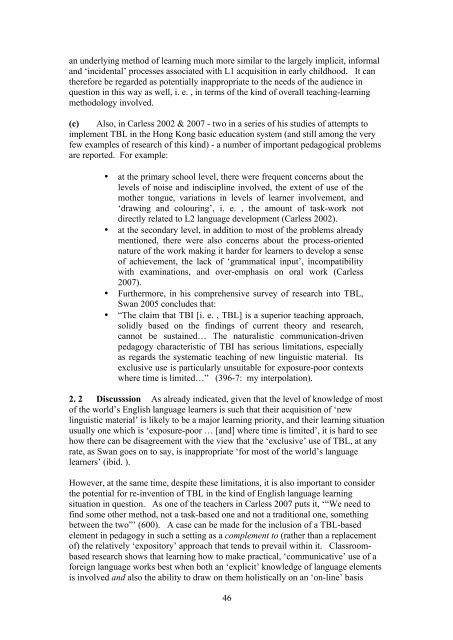RADICAL TEFL
2hqhXJd
2hqhXJd
Create successful ePaper yourself
Turn your PDF publications into a flip-book with our unique Google optimized e-Paper software.
an underlying method of learning much more similar to the largely implicit, informal<br />
and ‘incidental’ processes associated with L1 acquisition in early childhood. It can<br />
therefore be regarded as potentially inappropriate to the needs of the audience in<br />
question in this way as well, i. e. , in terms of the kind of overall teaching-learning<br />
methodology involved.<br />
(c) Also, in Carless 2002 & 2007 - two in a series of his studies of attempts to<br />
implement TBL in the Hong Kong basic education system (and still among the very<br />
few examples of research of this kind) - a number of important pedagogical problems<br />
are reported. For example:<br />
• at the primary school level, there were frequent concerns about the<br />
levels of noise and indiscipline involved, the extent of use of the<br />
mother tongue, variations in levels of learner involvement, and<br />
‘drawing and colouring’, i. e. , the amount of task-work not<br />
directly related to L2 language development (Carless 2002).<br />
• at the secondary level, in addition to most of the problems already<br />
mentioned, there were also concerns about the process-oriented<br />
nature of the work making it harder for learners to develop a sense<br />
of achievement, the lack of ‘grammatical input’, incompatibility<br />
with examinations, and over-emphasis on oral work (Carless<br />
2007).<br />
• Furthermore, in his comprehensive survey of research into TBL,<br />
Swan 2005 concludes that:<br />
• “The claim that TBI [i. e. , TBL] is a superior teaching approach,<br />
solidly based on the findings of current theory and research,<br />
cannot be sustained… The naturalistic communication-driven<br />
pedagogy characteristic of TBI has serious limitations, especially<br />
as regards the systematic teaching of new linguistic material. Its<br />
exclusive use is particularly unsuitable for exposure-poor contexts<br />
where time is limited…” (396-7: my interpolation).<br />
2. 2 Discusssion As already indicated, given that the level of knowledge of most<br />
of the world’s English language learners is such that their acquisition of ‘new<br />
linguistic material’ is likely to be a major learning priority, and their learning situation<br />
usually one which is ‘exposure-poor … [and] where time is limited’, it is hard to see<br />
how there can be disagreement with the view that the ‘exclusive’ use of TBL, at any<br />
rate, as Swan goes on to say, is inappropriate ‘for most of the world’s language<br />
learners’ (ibid. ).<br />
However, at the same time, despite these limitations, it is also important to consider<br />
the potential for re-invention of TBL in the kind of English language learning<br />
situation in question. As one of the teachers in Carless 2007 puts it, ‘“We need to<br />
find some other method, not a task-based one and not a traditional one, something<br />
between the two”’ (600). A case can be made for the inclusion of a TBL-based<br />
element in pedagogy in such a setting as a complement to (rather than a replacement<br />
of) the relatively ‘expository’ approach that tends to prevail within it. Classroombased<br />
research shows that learning how to make practical, ‘communicative’ use of a<br />
foreign language works best when both an ‘explicit’ knowledge of language elements<br />
is involved and also the ability to draw on them holistically on an ‘on-line’ basis<br />
46


